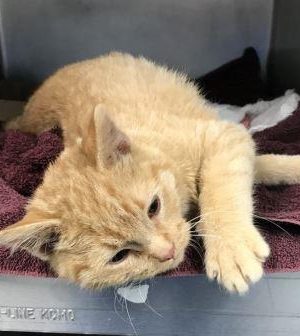- Do you subscribe to Dharma Dog Training’s Newsletter? You should.
- A Unique Campaign from The Humane Society of the United States
- Rabid bats in Omaha- Stay safe, prepared with these tips
- Springtime Activities in Omaha
- Mill Dog Monthly from Bailing Out Benji
- World Spay Day, Legislative Alert in Nebraska
- Attend the Nebraska Rescue Council’s monthly meeting this Saturday
- Five Hard-to-Ignore Reasons to Adopt!
- Paws in Pink to Benefit Breast Cancer Foundation
- VCA, Inc. Acquires MidWest Vet Specialists from Kansas State University
What To Do If Your Cat Has Fleas?

You are resting with your pet cat on a terrace, and she begins scratching. She scratches hard, is restless, and chews her skin. This can mean a lot of things, but you should look hard if she has FLEAS! You might feel distressed if she has them, but some pets can get them from neighboring cats or other infected animals such as rodents or rabbits. You can get more information about fleas when you click here.
If you have warm weather in your area, this might mean fleas and ticks. The rise in the temperatures can make it more hospitable for fleas’ eggs. They become active in temperatures such as 35◦C and a humidity of about 70 percent.
Fleas are dangerous, and they are active. They frequently feed on the blood of your pet and even from you. They jump from one animal to another, setting up a colony when conditions are favorable. There can burrow in the fur, and they stay hidden to ingest blood. This causes redness, inflammation, itching, and other irritating conditions to your cat and you.
So, enough about the description of fleas. You will surely feel them when they strike. The next thing to ask is, how do you get rid of them? Not temporarily, but for good.
How to Remove Fleas
1. Clean the Environment
Fleas can leave eggs on beddings and the host. The eggs can accumulate in clothes, carpets, beds, and car seats if these areas are places where your cat is often seen. It would help if you cleaned everything that came in contact with the infected cat.
The first thing- you need quick action. Quarantine the pet and isolate it. The second step is to collect all the rugs, beddings, pillowcases, and anything in the house that you may think have eggs on them. Water with detergent or soap is very useful in killing adults, pupa, larvae, and eggs.
What needs to be done after washing the beddings is to vacuum everything in the house. Vacuum the carpet, floors, cracks, corners, and everywhere where specks of dust can collect. This step collects the eggs on the carpet fibers. Immediately remove the bag outside of the house to prevent the larva from escaping.
You can steam clean everything in the house to remove larvae. You can hire cleaners to do this, but make sure to warn them first about the infested cat. They can apply pest control and insecticide treatment that is safe for small children and your pet.
2. Removing Fleas from the Host Animal
a. Bathing your Pet
Wash your cat with soapy water. There are insecticide shampoos that decide to kill fleas, and they are safe for cats. Ask your vet about the recommended shampoo that doesn’t have any toxic effects. You should stay away from products that contain diethyltoluamide, as this can cause some severe adverse reactions.
b. Comb the Hairs of your Pet Frequently
Use a special flea comb to your pet. Dispose of anything that you find on the comb in soapy water. Another alternative that you can do is wrap your hand with scotch tape. Make sure that the sticky part is out and pat your animal from head to tail. This can work if your cat is short-haired. There are also fur removal rollers and lint that can have the same effect.
c. Get Flea and Tick Collars
Collars work by repelling. They emit a type of gas that repels fleas. You can check this list of cat flea collars that will suit your pet’s needs. The gases are poisonous vapors that kill the eggs and the adults. The fumes are safe for pets, and they contain repelling shields. They are also natural and organic since they use essential oils.
Choose collars that are appropriate to the age and size of your pet. Read labels since some are strictly exclusive for large felines. They can be extremely potent and be dangerous when worn by a petite furry cat. When you choose the collar, watch out for the ingredients on the label. The label should clearly show the active ingredients that are used to kill the parasites. A laboratory should test these, and they were considered safe and ideal for cats.
d. Use of Topical Products
Topical products are liquids applied to a specific body area of your furry friend, and they typically last for a month. These solutions can start killing insects in just 12 hours after application. These topical products usually require prescriptions from your vet, but if you find the right one, you won’t have to reapply them every day.
A single dose of some of the topical products can get rid of black-legged ticks or fleas and provides up to 12 weeks of protection. They can break the life-cycle of insects, which are typically three months. They are easy to apply, and you won’t likely miss a dose.
How topical products work is that the medication enters the bloodstream and reaches the tissue fluids. When these are fed by ticks and ingest the liquid, they will die. A word of caution is that some of the products are not intended for human use. Don’t let your children play with the packaging and keep them in a safe, cool, and dry place.
A Final Word
Fleas are problems that need quick action before they become worse. But the good news is that even if they come in large numbers, they are easy to kill. After some weeks of dosing, bathing, and combing your cat, you will see that they will leave your pet alone. This will be the same in your home. You can eradicate the infestation if you frequently clean every nook and cranny inside your house, but this takes time and patience.
Latest News
-
Join Us at Pick A Pooch 2025: A Fun-Filled Weekend for the Whole Family
A Fun-Filled Weekend for Pet Lovers and Families Alike Mark...
- Posted 1 year ago
- 0
-
Beardmore Presenting Sponsor At This Years Pick-A-Pooch event
🐾 We are thrilled to announce that Beardmore Subaru is...
- Posted 1 month ago
- 0
-
How Having A Pet Can Change Your Life
Having a pet can open your heart in ways that...
- Posted 3 months ago
- 0
-
How To Improve The Life Of Your Senior Pet
Do you have an elderly fur baby and want to...
- Posted 3 months ago
- 0
-
Springtime Activities To Enjoy With Your Furry Friends
Are you preparing for warmer weather and want some ideas...
- Posted 4 months ago
- 0
-
Pros And Cons Of Microchipping Your Pets
Have you considered whether your pets should be microchipped and...
- Posted 5 months ago
- 0
-
The Best New Fun Toys For Dogs And Cats
The Best New Fun Toys For Dogs And Cats Did...
- Posted 5 months ago
- 0
-
Heartfelt Ways To Show Your Pet You Love Them
Did you know there are more ways to show your...
- Posted 6 months ago
- 0



















You must be logged in to post a comment Login